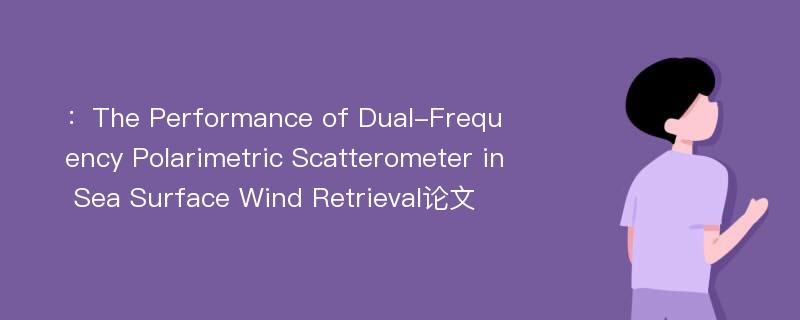
本文主要研究内容
作者(2019)在《The Performance of Dual-Frequency Polarimetric Scatterometer in Sea Surface Wind Retrieval》一文中研究指出:The wind retrieval performance of HY-2 A scanning scatterometer operating at Ku-band in HH and VV polarizations has been well evaluated in the wind speed range of 0–25 m s-1. In order to obtain more accurate ocean wind field, a potential extension of dual-frequency(C-band and Ku-band) polarimetric measurements is investigated for both low and very high wind speeds, from 5 to 45 m s-1. Based on the geophysical model functions of C-band and Ku-band, the simulation results show that the polarimetric measurements of Ku-band can improve the wind vector retrieval over the entire scatterometer swath, especially in nadir area, with the wind direction root-mean-square error(RMSE) less than 12? in the wind speed range of 5–25 m s-1. Furthermore, the results also show that C-band cross-polarization plays a very important role in improving the wind speed retrieval, with the wind speed retrieval accuracy better than 2 m s-1 for all wind conditions(0–45 m s-1). For extreme winds, the C-band HH backscatter coefficients modeled by CMOD5.N(H) and the ocean co-polarization ratio model at large incidence are used to retrieve sea surface wind vector. This result reveals that there is a big decrease of wind direction retrieval RMSE for extreme wind fields, and the retrieved result of C-band HH polarization is nearly the same as that of C-band VV polarization for low-to-high wind speed(5–25 m s-1). Thus, to improve the wind retrieval for all wind conditions, the dual-frequency polarimetric scatterometer with C-band and Ku-band horizontal polarization in inner beam, and C-band horizontal and Ku-band vertical polarization in outer beam, can be used to measure ocean winds. This study will contribute to the wind retrieval with merged satellites data and the future spaceborne scatterometer.
Abstract
The wind retrieval performance of HY-2 A scanning scatterometer operating at Ku-band in HH and VV polarizations has been well evaluated in the wind speed range of 0–25 m s-1. In order to obtain more accurate ocean wind field, a potential extension of dual-frequency(C-band and Ku-band) polarimetric measurements is investigated for both low and very high wind speeds, from 5 to 45 m s-1. Based on the geophysical model functions of C-band and Ku-band, the simulation results show that the polarimetric measurements of Ku-band can improve the wind vector retrieval over the entire scatterometer swath, especially in nadir area, with the wind direction root-mean-square error(RMSE) less than 12? in the wind speed range of 5–25 m s-1. Furthermore, the results also show that C-band cross-polarization plays a very important role in improving the wind speed retrieval, with the wind speed retrieval accuracy better than 2 m s-1 for all wind conditions(0–45 m s-1). For extreme winds, the C-band HH backscatter coefficients modeled by CMOD5.N(H) and the ocean co-polarization ratio model at large incidence are used to retrieve sea surface wind vector. This result reveals that there is a big decrease of wind direction retrieval RMSE for extreme wind fields, and the retrieved result of C-band HH polarization is nearly the same as that of C-band VV polarization for low-to-high wind speed(5–25 m s-1). Thus, to improve the wind retrieval for all wind conditions, the dual-frequency polarimetric scatterometer with C-band and Ku-band horizontal polarization in inner beam, and C-band horizontal and Ku-band vertical polarization in outer beam, can be used to measure ocean winds. This study will contribute to the wind retrieval with merged satellites data and the future spaceborne scatterometer.
论文参考文献
论文详细介绍
论文作者分别是来自Journal of Ocean University of China的,发表于刊物Journal of Ocean University of China2019年05期论文,是一篇关于,Journal of Ocean University of China2019年05期论文的文章。本文可供学术参考使用,各位学者可以免费参考阅读下载,文章观点不代表本站观点,资料来自Journal of Ocean University of China2019年05期论文网站,若本站收录的文献无意侵犯了您的著作版权,请联系我们删除。
